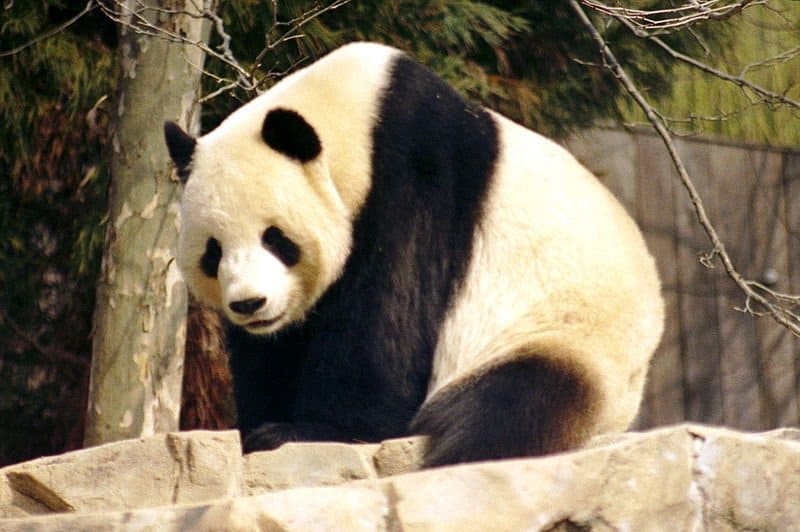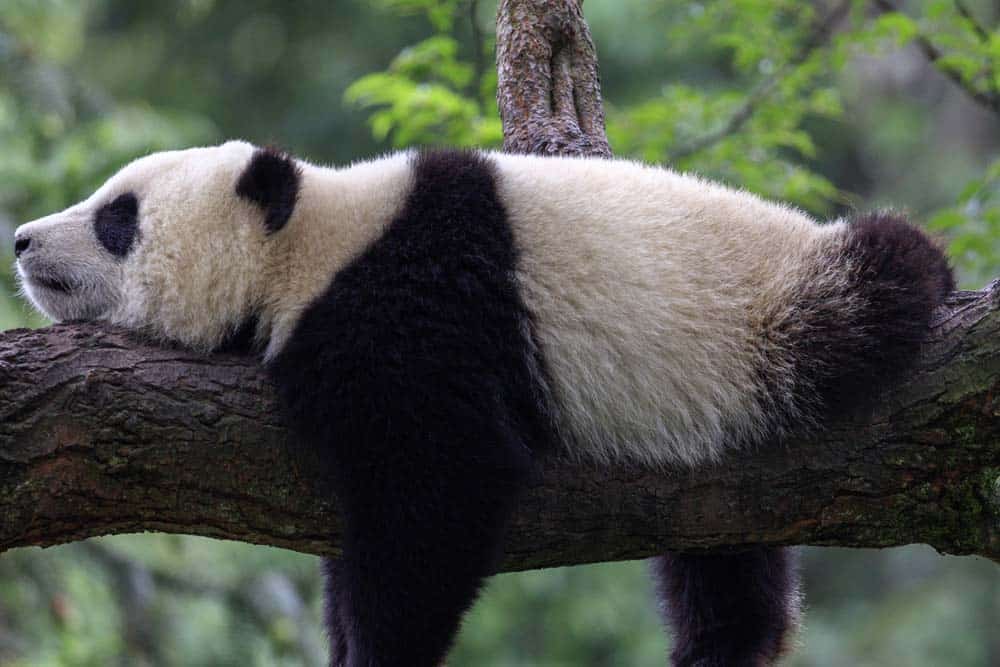Pandas are among those instantly recognizable animals. This is due to their black and white coloration, especially the black circles around their eyes. It is their sweet and cuddly appearance that has made them a favorite animal among many.
However, even with all the cuteness in the world, the panda population continues to decline. So how many pandas are left in the world? Let’s find out more about the panda population and what’s being done to improve their numbers.
How Many Pandas Are Left In The World?

In their native habitat, there are only 1,864 giant pandas, and 600 others live in zoos or breeding centers worldwide.
©KoSei/Shutterstock.com
Many of us find pandas adorable due to their teddy-bear-like appearance. Historically, these giant bears have lived only in China, where they have remained a native species. As of right now, there are only 1,864 pandas that remain in the wild, according to the World Wildlife Fund (WWF). Meanwhile, there have been reports that there are roughly 600 pandas living in captivity. In contrast to the late 1970s when numbers were around 1000, this is a genuine success story.
According to the International Union for Conservation of Nature (IUCN), the giant panda is considered “vulnerable,” which is in between “near threatened” and “endangered.” In light of this, what is going on with the panda population? Why has this generally solitary creature that feeds on bamboo become so threatened? Let’s take a look at why the panda populations are declining.
What Caused Panda Populations To Decline?

There is still a serious threat to the survival of pandas due to habitat loss and fragmentation.
©Jeff Kubina – Public Domain
There are a variety of factors that negatively impact panda populations. The fact that panda bears are primarily folivores is one of the biggest factors. Folivores are herbivores that eat leaves. Because pandas eat bamboo shoots and leaves primarily, this is an important point to remember. Here is an overview of how deforestation and other factors have affected panda bears.
Habitat Loss
Wild pandas are most threatened by deforestation. In fact, this is one of the main reasons they are still a vulnerable species today. Pandas have lost their habitat permanently in some areas because of deforestation. There was once a time when wild pandas would roam through bamboo forests throughout many parts of Asia. Currently, wild pandas can only be found in China.
Pandas are on the verge of extinction as a result of habitat loss. Bamboo forests are the pandas’ main food source. If they are fully cleared out, then their food source completely disappears. As a result of deforestation, pandas will starve to death if they don’t have access to bamboo.
Adaptability Issues
It is not unusual for animals to adapt to human activity in once wild areas. You may have noticed that rats and mice have adapted to living among humans. Many animals have found ways to integrate into their new habitats, including birds, foxes, and even coyotes. Pandas, however, cannot live successfully among humans. The reason for this is that their diet requires them to eat bamboo exclusively. There is nothing else that the pandas’ digestive systems can digest properly. Even if they ate something other than bamboo, pandas couldn’t blend in safely in cities. In contrast to smaller animals like squirrels, rats, and even wild dogs and cats, pandas are far too large to live among humans.
Illegal Hunting of Wild Pandas
The illegal poaching of threatened species may seem unimaginable, but it, unfortunately, does happen. It is possible for poachers to make a lot of money on the black market by selling panda skins and pelts. Therefore, the Chinese government decided to step in with some harsh laws in order to put an end to this situation. The Chinese government imposes strict penalties on anyone caught poaching pandas, but some poachers persist despite the dangers. Since the wild panda population is so low, even one panda killed by poachers is a tragedy.
Is Anything Being Done To Help Panda Populations?

China’s government has been implementing many actions to ensure panda populations do not continue to decrease.
©clkraus/Shutterstock.com
In September 2016, the IUCN declared that giant pandas would no longer be listed as endangered. They have now been designated as “vulnerable.” The Chinese government has made numerous efforts to protect pandas, which is why the situation is getting better. Several steps have been taken by the government to ensure the survival of the giant panda.
These actions include:
1. Conserving the habitat of giant pandas
In order to save giant pandas, it is crucial to preserve their habitat. It would be impossible for pandas to survive outside of captivity if they have no habitat to live in. A total of 13 panda nature reserve areas have been set up by the Chinese government in order to protect giant pandas’ habitats. The fields that were used for farming have been left as forests in order to grow back over time. Things are getting better for trees and bamboo, and the habitat is recovering. Forest reserve areas have also been separated from farming practices surrounding the forests.
2. Passing laws to stop the illegal hunting of pandas
There is a growing problem of poaching among panda populations, as we mentioned earlier in this article. Buying and selling panda fur on the black market is a lucrative business that offers a lot of money to be made. As part of the Chinese government’s efforts to protect giant pandas from hunting and smuggling, laws and severe penalties have been enacted. Panda hunting and smuggling are now punishable by a minimum sentence of ten years in jail and a fine if they are found guilty.
3. Helping pandas breed while in captivity
Reproductive difficulties are common among pandas. As a result, China has made great efforts to help the panda population with its breeding problems. A great deal of bamboo stood dead during the 1980s in the Qionglai Mountains, one of the giant pandas’ most important habitat areas. There were many giant pandas that were starving, so they were rescued and brought to the Chengdu Zoo. To separate their research work on giant pandas, the Chengdu Panda Center was established in 1987. Since then, more than 150 giant pandas have been born from the original six starving pandas.
The photo featured at the top of this post is © iStock.com/wrangel
Thank you for reading! Have some feedback for us? Contact the AZ Animals editorial team.






